Critical Analysis of Employee Satisfaction and Psychological Factors
VerifiedAdded on 2023/01/19
|12
|3818
|22
Essay
AI Summary
This essay provides a critical analysis of research concerning psychological phenomena and employee satisfaction. It begins with an introduction that highlights the importance of addressing employee satisfaction in contemporary business environments. The main body delves into key theories, including Maslow's Hierarchy of Needs and Herzberg's Two-Factor Theory, explaining how they relate to employee behavior, engagement, and satisfaction. The essay then presents research questions and explains how these theories form a fundamental base for further research. It also discusses various methodologies, their strengths, weaknesses, and potential threats to validity, focusing on research design and approach. Reflective models are employed to demonstrate an understanding of the research process and contrasting theoretical perspectives and methodological approaches. The essay concludes by summarizing the findings and offering insights into the complex interplay between psychology and employee satisfaction within organizations.

CRITICAL ANALYSIS
Paraphrase This Document
Need a fresh take? Get an instant paraphrase of this document with our AI Paraphraser
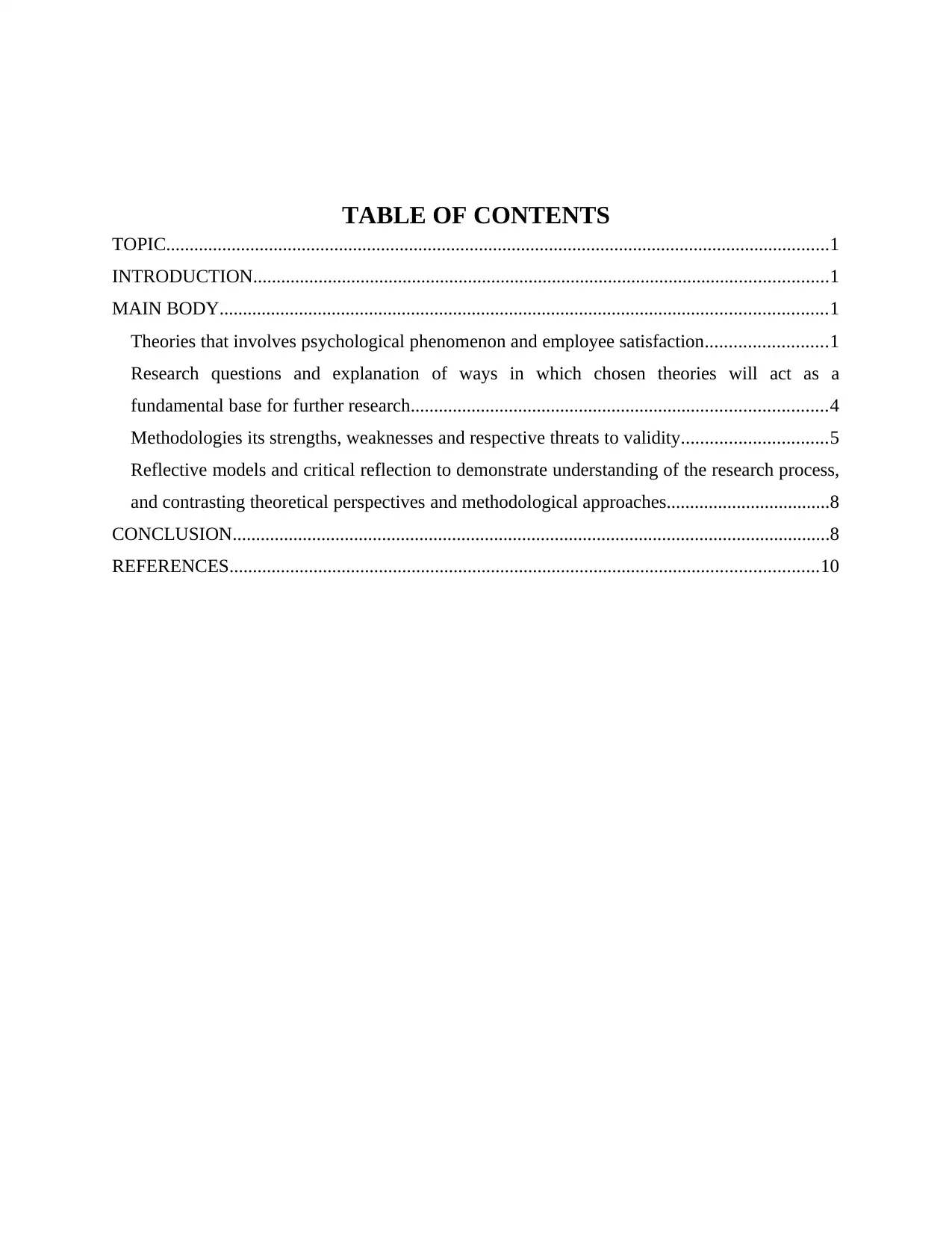
TABLE OF CONTENTS
TOPIC..............................................................................................................................................1
INTRODUCTION...........................................................................................................................1
MAIN BODY..................................................................................................................................1
Theories that involves psychological phenomenon and employee satisfaction..........................1
Research questions and explanation of ways in which chosen theories will act as a
fundamental base for further research.........................................................................................4
Methodologies its strengths, weaknesses and respective threats to validity...............................5
Reflective models and critical reflection to demonstrate understanding of the research process,
and contrasting theoretical perspectives and methodological approaches...................................8
CONCLUSION................................................................................................................................8
REFERENCES..............................................................................................................................10
TOPIC..............................................................................................................................................1
INTRODUCTION...........................................................................................................................1
MAIN BODY..................................................................................................................................1
Theories that involves psychological phenomenon and employee satisfaction..........................1
Research questions and explanation of ways in which chosen theories will act as a
fundamental base for further research.........................................................................................4
Methodologies its strengths, weaknesses and respective threats to validity...............................5
Reflective models and critical reflection to demonstrate understanding of the research process,
and contrasting theoretical perspectives and methodological approaches...................................8
CONCLUSION................................................................................................................................8
REFERENCES..............................................................................................................................10
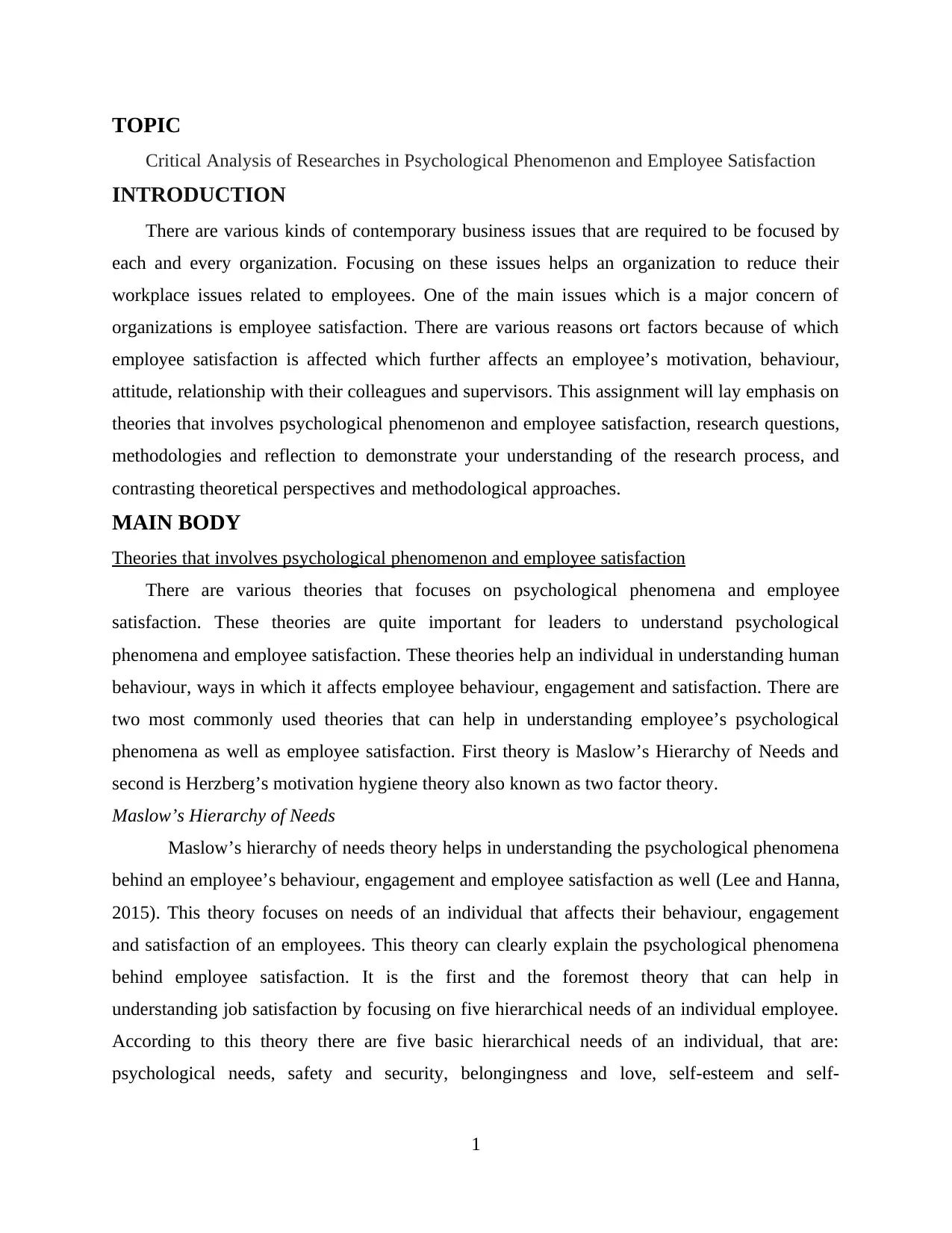
TOPIC
Critical Analysis of Researches in Psychological Phenomenon and Employee Satisfaction
INTRODUCTION
There are various kinds of contemporary business issues that are required to be focused by
each and every organization. Focusing on these issues helps an organization to reduce their
workplace issues related to employees. One of the main issues which is a major concern of
organizations is employee satisfaction. There are various reasons ort factors because of which
employee satisfaction is affected which further affects an employee’s motivation, behaviour,
attitude, relationship with their colleagues and supervisors. This assignment will lay emphasis on
theories that involves psychological phenomenon and employee satisfaction, research questions,
methodologies and reflection to demonstrate your understanding of the research process, and
contrasting theoretical perspectives and methodological approaches.
MAIN BODY
Theories that involves psychological phenomenon and employee satisfaction
There are various theories that focuses on psychological phenomena and employee
satisfaction. These theories are quite important for leaders to understand psychological
phenomena and employee satisfaction. These theories help an individual in understanding human
behaviour, ways in which it affects employee behaviour, engagement and satisfaction. There are
two most commonly used theories that can help in understanding employee’s psychological
phenomena as well as employee satisfaction. First theory is Maslow’s Hierarchy of Needs and
second is Herzberg’s motivation hygiene theory also known as two factor theory.
Maslow’s Hierarchy of Needs
Maslow’s hierarchy of needs theory helps in understanding the psychological phenomena
behind an employee’s behaviour, engagement and employee satisfaction as well (Lee and Hanna,
2015). This theory focuses on needs of an individual that affects their behaviour, engagement
and satisfaction of an employees. This theory can clearly explain the psychological phenomena
behind employee satisfaction. It is the first and the foremost theory that can help in
understanding job satisfaction by focusing on five hierarchical needs of an individual employee.
According to this theory there are five basic hierarchical needs of an individual, that are:
psychological needs, safety and security, belongingness and love, self-esteem and self-
1
Critical Analysis of Researches in Psychological Phenomenon and Employee Satisfaction
INTRODUCTION
There are various kinds of contemporary business issues that are required to be focused by
each and every organization. Focusing on these issues helps an organization to reduce their
workplace issues related to employees. One of the main issues which is a major concern of
organizations is employee satisfaction. There are various reasons ort factors because of which
employee satisfaction is affected which further affects an employee’s motivation, behaviour,
attitude, relationship with their colleagues and supervisors. This assignment will lay emphasis on
theories that involves psychological phenomenon and employee satisfaction, research questions,
methodologies and reflection to demonstrate your understanding of the research process, and
contrasting theoretical perspectives and methodological approaches.
MAIN BODY
Theories that involves psychological phenomenon and employee satisfaction
There are various theories that focuses on psychological phenomena and employee
satisfaction. These theories are quite important for leaders to understand psychological
phenomena and employee satisfaction. These theories help an individual in understanding human
behaviour, ways in which it affects employee behaviour, engagement and satisfaction. There are
two most commonly used theories that can help in understanding employee’s psychological
phenomena as well as employee satisfaction. First theory is Maslow’s Hierarchy of Needs and
second is Herzberg’s motivation hygiene theory also known as two factor theory.
Maslow’s Hierarchy of Needs
Maslow’s hierarchy of needs theory helps in understanding the psychological phenomena
behind an employee’s behaviour, engagement and employee satisfaction as well (Lee and Hanna,
2015). This theory focuses on needs of an individual that affects their behaviour, engagement
and satisfaction of an employees. This theory can clearly explain the psychological phenomena
behind employee satisfaction. It is the first and the foremost theory that can help in
understanding job satisfaction by focusing on five hierarchical needs of an individual employee.
According to this theory there are five basic hierarchical needs of an individual, that are:
psychological needs, safety and security, belongingness and love, self-esteem and self-
1
⊘ This is a preview!⊘
Do you want full access?
Subscribe today to unlock all pages.

Trusted by 1+ million students worldwide
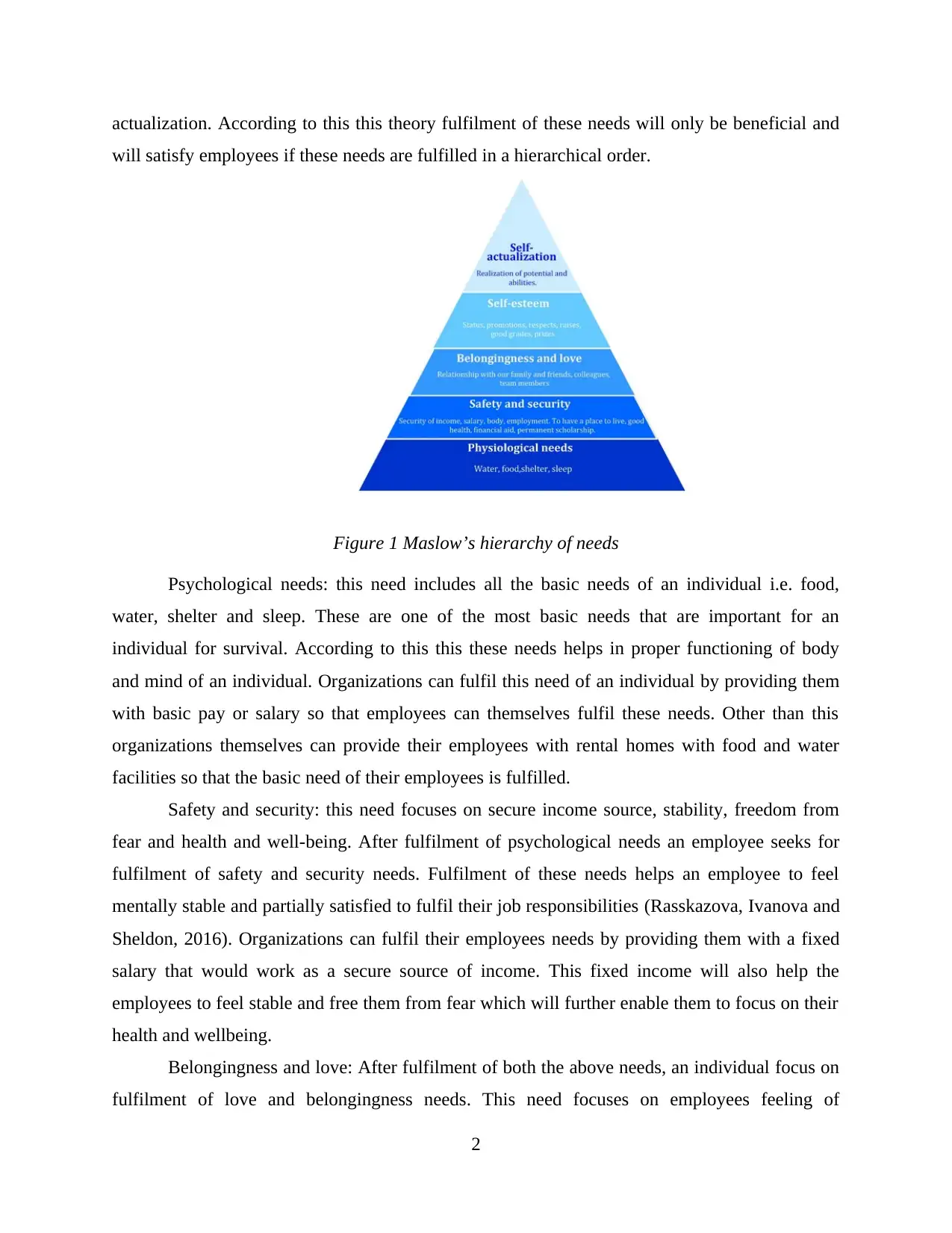
actualization. According to this this theory fulfilment of these needs will only be beneficial and
will satisfy employees if these needs are fulfilled in a hierarchical order.
Figure 1 Maslow’s hierarchy of needs
Psychological needs: this need includes all the basic needs of an individual i.e. food,
water, shelter and sleep. These are one of the most basic needs that are important for an
individual for survival. According to this this these needs helps in proper functioning of body
and mind of an individual. Organizations can fulfil this need of an individual by providing them
with basic pay or salary so that employees can themselves fulfil these needs. Other than this
organizations themselves can provide their employees with rental homes with food and water
facilities so that the basic need of their employees is fulfilled.
Safety and security: this need focuses on secure income source, stability, freedom from
fear and health and well-being. After fulfilment of psychological needs an employee seeks for
fulfilment of safety and security needs. Fulfilment of these needs helps an employee to feel
mentally stable and partially satisfied to fulfil their job responsibilities (Rasskazova, Ivanova and
Sheldon, 2016). Organizations can fulfil their employees needs by providing them with a fixed
salary that would work as a secure source of income. This fixed income will also help the
employees to feel stable and free them from fear which will further enable them to focus on their
health and wellbeing.
Belongingness and love: After fulfilment of both the above needs, an individual focus on
fulfilment of love and belongingness needs. This need focuses on employees feeling of
2
will satisfy employees if these needs are fulfilled in a hierarchical order.
Figure 1 Maslow’s hierarchy of needs
Psychological needs: this need includes all the basic needs of an individual i.e. food,
water, shelter and sleep. These are one of the most basic needs that are important for an
individual for survival. According to this this these needs helps in proper functioning of body
and mind of an individual. Organizations can fulfil this need of an individual by providing them
with basic pay or salary so that employees can themselves fulfil these needs. Other than this
organizations themselves can provide their employees with rental homes with food and water
facilities so that the basic need of their employees is fulfilled.
Safety and security: this need focuses on secure income source, stability, freedom from
fear and health and well-being. After fulfilment of psychological needs an employee seeks for
fulfilment of safety and security needs. Fulfilment of these needs helps an employee to feel
mentally stable and partially satisfied to fulfil their job responsibilities (Rasskazova, Ivanova and
Sheldon, 2016). Organizations can fulfil their employees needs by providing them with a fixed
salary that would work as a secure source of income. This fixed income will also help the
employees to feel stable and free them from fear which will further enable them to focus on their
health and wellbeing.
Belongingness and love: After fulfilment of both the above needs, an individual focus on
fulfilment of love and belongingness needs. This need focuses on employees feeling of
2
Paraphrase This Document
Need a fresh take? Get an instant paraphrase of this document with our AI Paraphraser
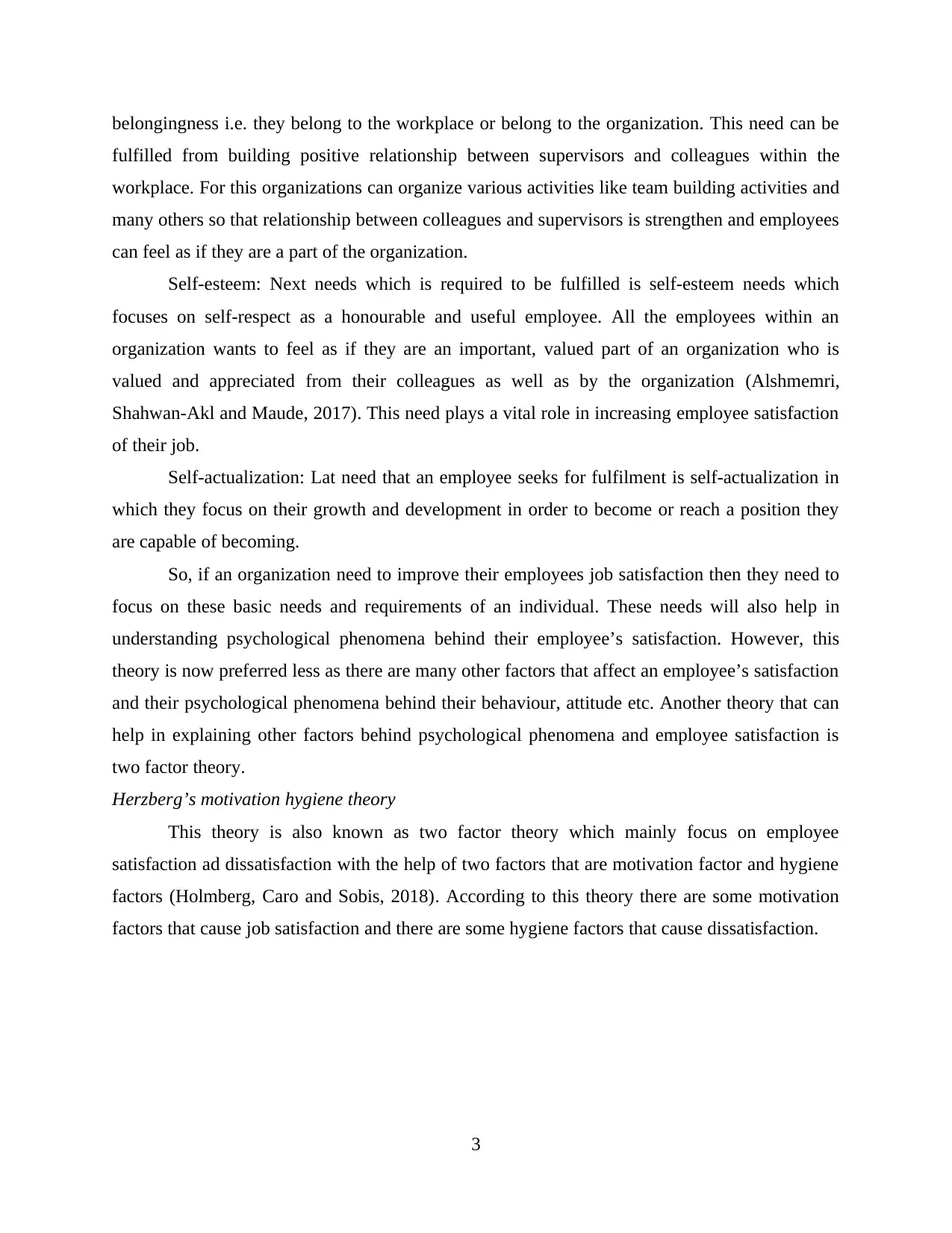
belongingness i.e. they belong to the workplace or belong to the organization. This need can be
fulfilled from building positive relationship between supervisors and colleagues within the
workplace. For this organizations can organize various activities like team building activities and
many others so that relationship between colleagues and supervisors is strengthen and employees
can feel as if they are a part of the organization.
Self-esteem: Next needs which is required to be fulfilled is self-esteem needs which
focuses on self-respect as a honourable and useful employee. All the employees within an
organization wants to feel as if they are an important, valued part of an organization who is
valued and appreciated from their colleagues as well as by the organization (Alshmemri,
Shahwan-Akl and Maude, 2017). This need plays a vital role in increasing employee satisfaction
of their job.
Self-actualization: Lat need that an employee seeks for fulfilment is self-actualization in
which they focus on their growth and development in order to become or reach a position they
are capable of becoming.
So, if an organization need to improve their employees job satisfaction then they need to
focus on these basic needs and requirements of an individual. These needs will also help in
understanding psychological phenomena behind their employee’s satisfaction. However, this
theory is now preferred less as there are many other factors that affect an employee’s satisfaction
and their psychological phenomena behind their behaviour, attitude etc. Another theory that can
help in explaining other factors behind psychological phenomena and employee satisfaction is
two factor theory.
Herzberg’s motivation hygiene theory
This theory is also known as two factor theory which mainly focus on employee
satisfaction ad dissatisfaction with the help of two factors that are motivation factor and hygiene
factors (Holmberg, Caro and Sobis, 2018). According to this theory there are some motivation
factors that cause job satisfaction and there are some hygiene factors that cause dissatisfaction.
3
fulfilled from building positive relationship between supervisors and colleagues within the
workplace. For this organizations can organize various activities like team building activities and
many others so that relationship between colleagues and supervisors is strengthen and employees
can feel as if they are a part of the organization.
Self-esteem: Next needs which is required to be fulfilled is self-esteem needs which
focuses on self-respect as a honourable and useful employee. All the employees within an
organization wants to feel as if they are an important, valued part of an organization who is
valued and appreciated from their colleagues as well as by the organization (Alshmemri,
Shahwan-Akl and Maude, 2017). This need plays a vital role in increasing employee satisfaction
of their job.
Self-actualization: Lat need that an employee seeks for fulfilment is self-actualization in
which they focus on their growth and development in order to become or reach a position they
are capable of becoming.
So, if an organization need to improve their employees job satisfaction then they need to
focus on these basic needs and requirements of an individual. These needs will also help in
understanding psychological phenomena behind their employee’s satisfaction. However, this
theory is now preferred less as there are many other factors that affect an employee’s satisfaction
and their psychological phenomena behind their behaviour, attitude etc. Another theory that can
help in explaining other factors behind psychological phenomena and employee satisfaction is
two factor theory.
Herzberg’s motivation hygiene theory
This theory is also known as two factor theory which mainly focus on employee
satisfaction ad dissatisfaction with the help of two factors that are motivation factor and hygiene
factors (Holmberg, Caro and Sobis, 2018). According to this theory there are some motivation
factors that cause job satisfaction and there are some hygiene factors that cause dissatisfaction.
3
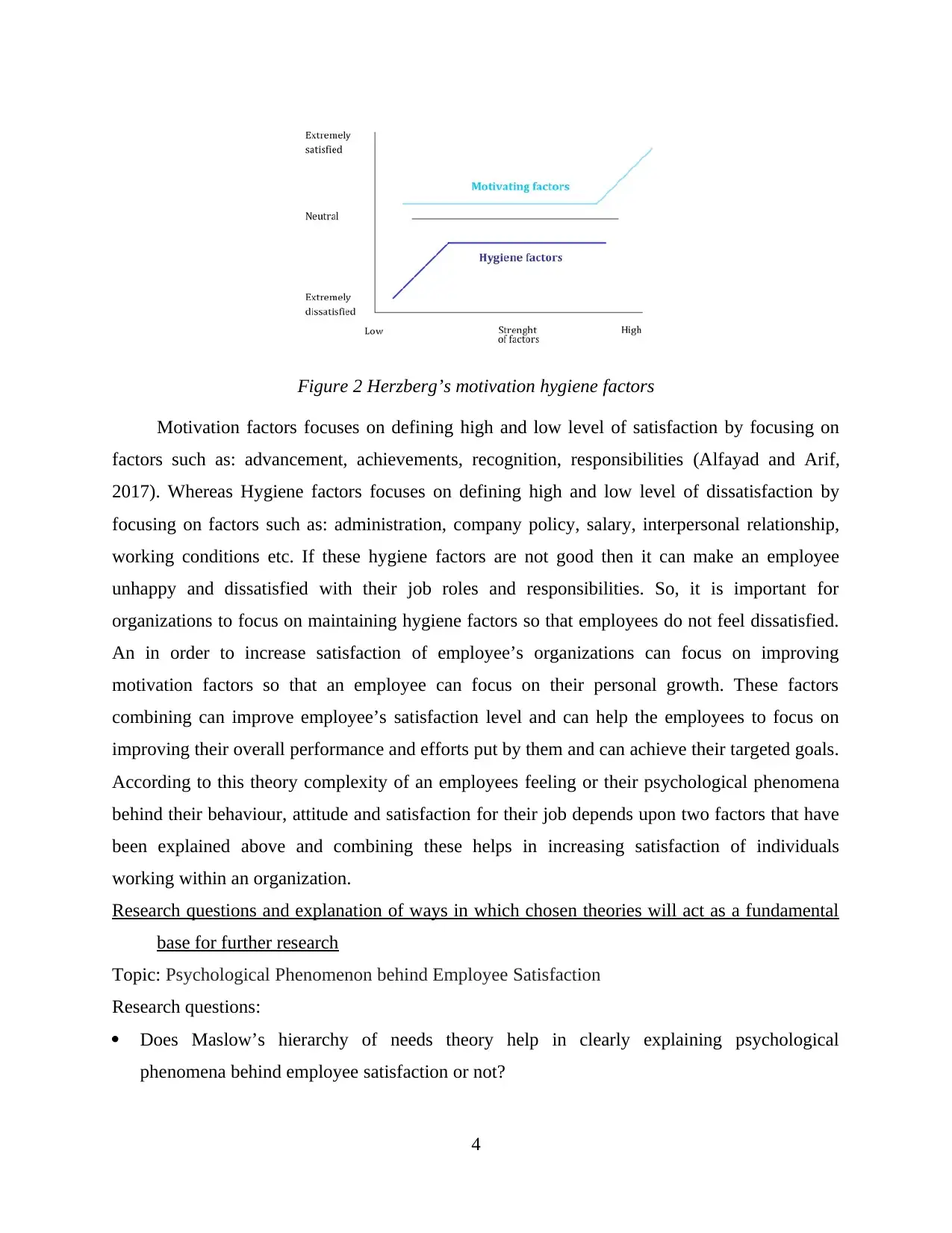
Figure 2 Herzberg’s motivation hygiene factors
Motivation factors focuses on defining high and low level of satisfaction by focusing on
factors such as: advancement, achievements, recognition, responsibilities (Alfayad and Arif,
2017). Whereas Hygiene factors focuses on defining high and low level of dissatisfaction by
focusing on factors such as: administration, company policy, salary, interpersonal relationship,
working conditions etc. If these hygiene factors are not good then it can make an employee
unhappy and dissatisfied with their job roles and responsibilities. So, it is important for
organizations to focus on maintaining hygiene factors so that employees do not feel dissatisfied.
An in order to increase satisfaction of employee’s organizations can focus on improving
motivation factors so that an employee can focus on their personal growth. These factors
combining can improve employee’s satisfaction level and can help the employees to focus on
improving their overall performance and efforts put by them and can achieve their targeted goals.
According to this theory complexity of an employees feeling or their psychological phenomena
behind their behaviour, attitude and satisfaction for their job depends upon two factors that have
been explained above and combining these helps in increasing satisfaction of individuals
working within an organization.
Research questions and explanation of ways in which chosen theories will act as a fundamental
base for further research
Topic: Psychological Phenomenon behind Employee Satisfaction
Research questions:
Does Maslow’s hierarchy of needs theory help in clearly explaining psychological
phenomena behind employee satisfaction or not?
4
Motivation factors focuses on defining high and low level of satisfaction by focusing on
factors such as: advancement, achievements, recognition, responsibilities (Alfayad and Arif,
2017). Whereas Hygiene factors focuses on defining high and low level of dissatisfaction by
focusing on factors such as: administration, company policy, salary, interpersonal relationship,
working conditions etc. If these hygiene factors are not good then it can make an employee
unhappy and dissatisfied with their job roles and responsibilities. So, it is important for
organizations to focus on maintaining hygiene factors so that employees do not feel dissatisfied.
An in order to increase satisfaction of employee’s organizations can focus on improving
motivation factors so that an employee can focus on their personal growth. These factors
combining can improve employee’s satisfaction level and can help the employees to focus on
improving their overall performance and efforts put by them and can achieve their targeted goals.
According to this theory complexity of an employees feeling or their psychological phenomena
behind their behaviour, attitude and satisfaction for their job depends upon two factors that have
been explained above and combining these helps in increasing satisfaction of individuals
working within an organization.
Research questions and explanation of ways in which chosen theories will act as a fundamental
base for further research
Topic: Psychological Phenomenon behind Employee Satisfaction
Research questions:
Does Maslow’s hierarchy of needs theory help in clearly explaining psychological
phenomena behind employee satisfaction or not?
4
⊘ This is a preview!⊘
Do you want full access?
Subscribe today to unlock all pages.

Trusted by 1+ million students worldwide
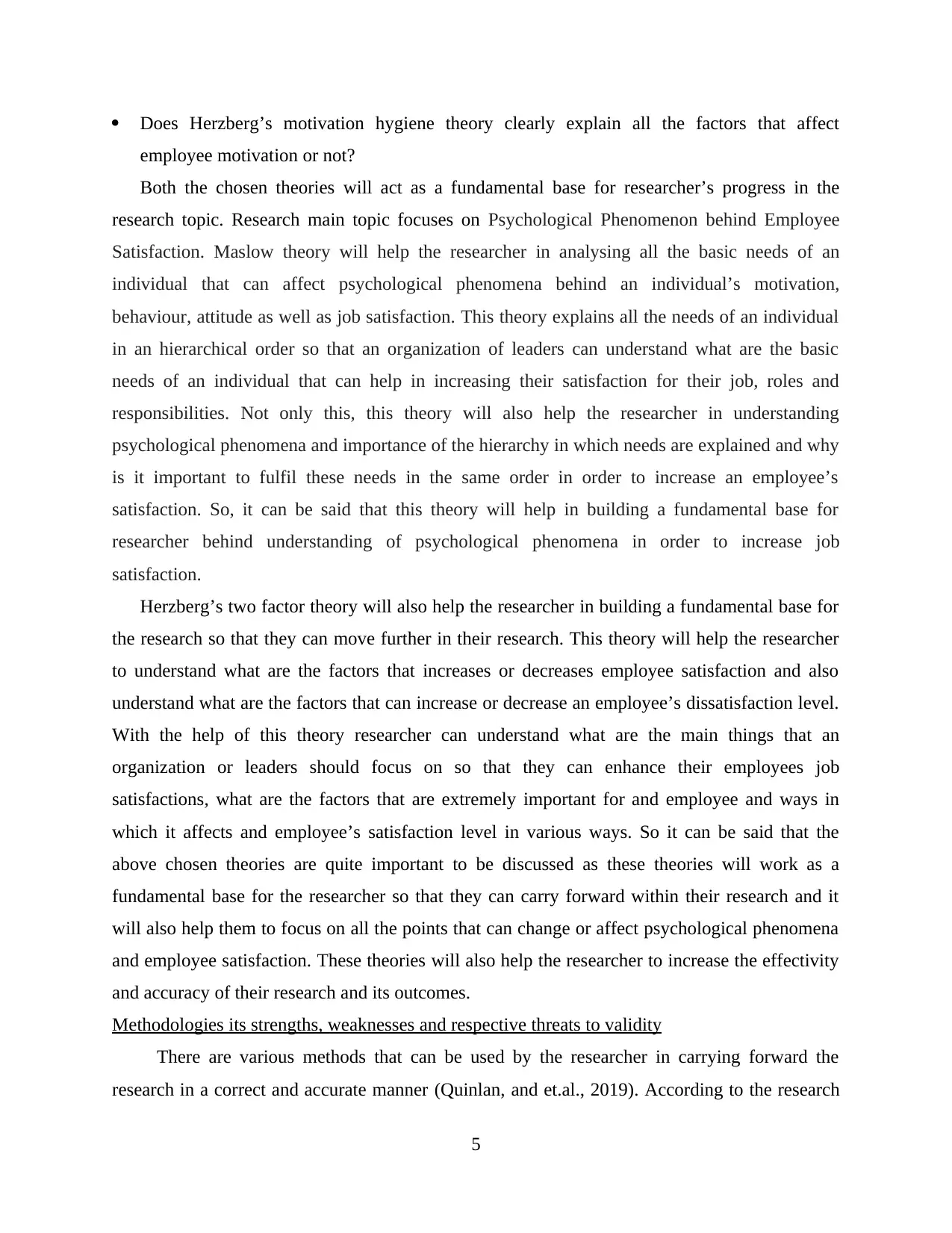
Does Herzberg’s motivation hygiene theory clearly explain all the factors that affect
employee motivation or not?
Both the chosen theories will act as a fundamental base for researcher’s progress in the
research topic. Research main topic focuses on Psychological Phenomenon behind Employee
Satisfaction. Maslow theory will help the researcher in analysing all the basic needs of an
individual that can affect psychological phenomena behind an individual’s motivation,
behaviour, attitude as well as job satisfaction. This theory explains all the needs of an individual
in an hierarchical order so that an organization of leaders can understand what are the basic
needs of an individual that can help in increasing their satisfaction for their job, roles and
responsibilities. Not only this, this theory will also help the researcher in understanding
psychological phenomena and importance of the hierarchy in which needs are explained and why
is it important to fulfil these needs in the same order in order to increase an employee’s
satisfaction. So, it can be said that this theory will help in building a fundamental base for
researcher behind understanding of psychological phenomena in order to increase job
satisfaction.
Herzberg’s two factor theory will also help the researcher in building a fundamental base for
the research so that they can move further in their research. This theory will help the researcher
to understand what are the factors that increases or decreases employee satisfaction and also
understand what are the factors that can increase or decrease an employee’s dissatisfaction level.
With the help of this theory researcher can understand what are the main things that an
organization or leaders should focus on so that they can enhance their employees job
satisfactions, what are the factors that are extremely important for and employee and ways in
which it affects and employee’s satisfaction level in various ways. So it can be said that the
above chosen theories are quite important to be discussed as these theories will work as a
fundamental base for the researcher so that they can carry forward within their research and it
will also help them to focus on all the points that can change or affect psychological phenomena
and employee satisfaction. These theories will also help the researcher to increase the effectivity
and accuracy of their research and its outcomes.
Methodologies its strengths, weaknesses and respective threats to validity
There are various methods that can be used by the researcher in carrying forward the
research in a correct and accurate manner (Quinlan, and et.al., 2019). According to the research
5
employee motivation or not?
Both the chosen theories will act as a fundamental base for researcher’s progress in the
research topic. Research main topic focuses on Psychological Phenomenon behind Employee
Satisfaction. Maslow theory will help the researcher in analysing all the basic needs of an
individual that can affect psychological phenomena behind an individual’s motivation,
behaviour, attitude as well as job satisfaction. This theory explains all the needs of an individual
in an hierarchical order so that an organization of leaders can understand what are the basic
needs of an individual that can help in increasing their satisfaction for their job, roles and
responsibilities. Not only this, this theory will also help the researcher in understanding
psychological phenomena and importance of the hierarchy in which needs are explained and why
is it important to fulfil these needs in the same order in order to increase an employee’s
satisfaction. So, it can be said that this theory will help in building a fundamental base for
researcher behind understanding of psychological phenomena in order to increase job
satisfaction.
Herzberg’s two factor theory will also help the researcher in building a fundamental base for
the research so that they can move further in their research. This theory will help the researcher
to understand what are the factors that increases or decreases employee satisfaction and also
understand what are the factors that can increase or decrease an employee’s dissatisfaction level.
With the help of this theory researcher can understand what are the main things that an
organization or leaders should focus on so that they can enhance their employees job
satisfactions, what are the factors that are extremely important for and employee and ways in
which it affects and employee’s satisfaction level in various ways. So it can be said that the
above chosen theories are quite important to be discussed as these theories will work as a
fundamental base for the researcher so that they can carry forward within their research and it
will also help them to focus on all the points that can change or affect psychological phenomena
and employee satisfaction. These theories will also help the researcher to increase the effectivity
and accuracy of their research and its outcomes.
Methodologies its strengths, weaknesses and respective threats to validity
There are various methods that can be used by the researcher in carrying forward the
research in a correct and accurate manner (Quinlan, and et.al., 2019). According to the research
5
Paraphrase This Document
Need a fresh take? Get an instant paraphrase of this document with our AI Paraphraser
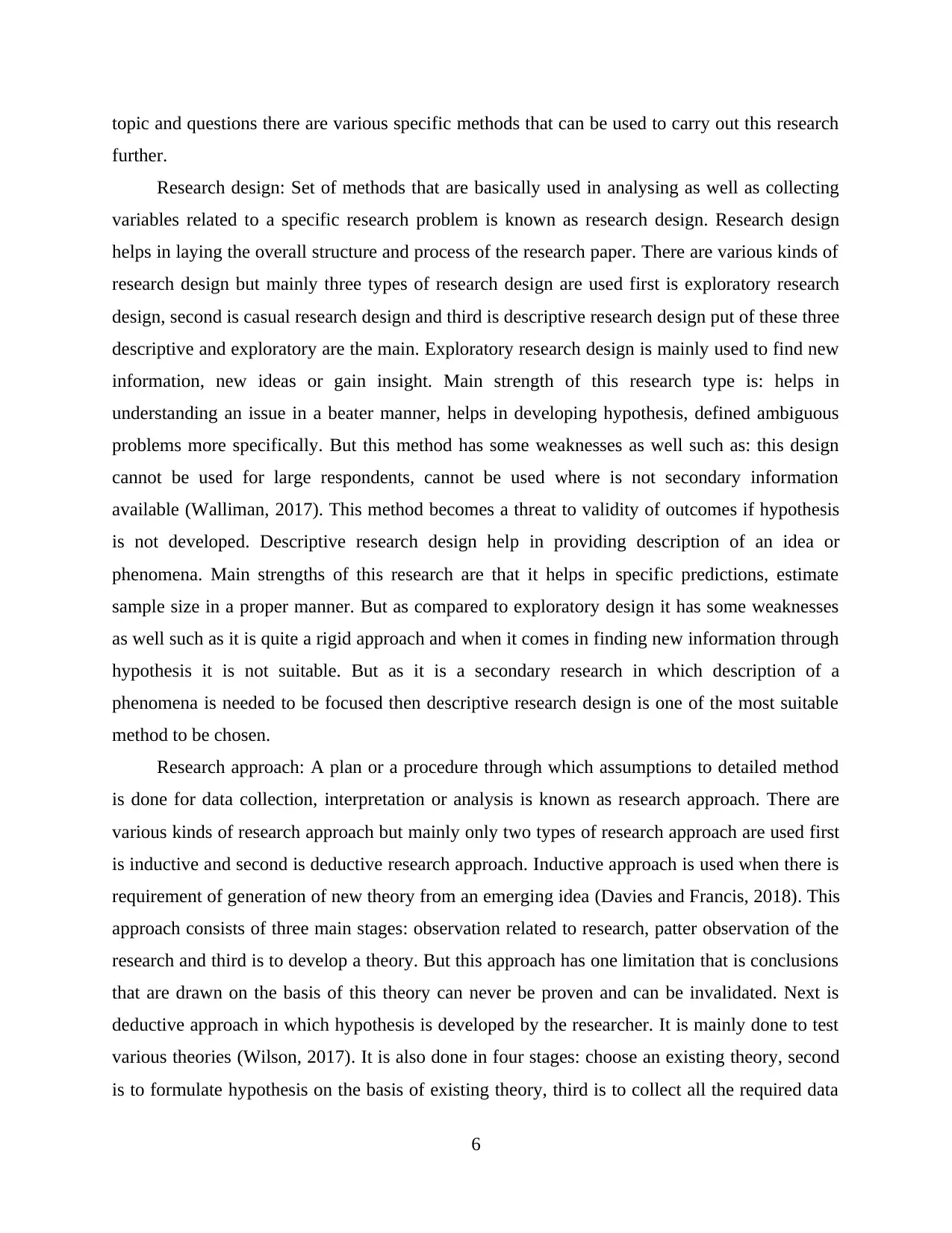
topic and questions there are various specific methods that can be used to carry out this research
further.
Research design: Set of methods that are basically used in analysing as well as collecting
variables related to a specific research problem is known as research design. Research design
helps in laying the overall structure and process of the research paper. There are various kinds of
research design but mainly three types of research design are used first is exploratory research
design, second is casual research design and third is descriptive research design put of these three
descriptive and exploratory are the main. Exploratory research design is mainly used to find new
information, new ideas or gain insight. Main strength of this research type is: helps in
understanding an issue in a beater manner, helps in developing hypothesis, defined ambiguous
problems more specifically. But this method has some weaknesses as well such as: this design
cannot be used for large respondents, cannot be used where is not secondary information
available (Walliman, 2017). This method becomes a threat to validity of outcomes if hypothesis
is not developed. Descriptive research design help in providing description of an idea or
phenomena. Main strengths of this research are that it helps in specific predictions, estimate
sample size in a proper manner. But as compared to exploratory design it has some weaknesses
as well such as it is quite a rigid approach and when it comes in finding new information through
hypothesis it is not suitable. But as it is a secondary research in which description of a
phenomena is needed to be focused then descriptive research design is one of the most suitable
method to be chosen.
Research approach: A plan or a procedure through which assumptions to detailed method
is done for data collection, interpretation or analysis is known as research approach. There are
various kinds of research approach but mainly only two types of research approach are used first
is inductive and second is deductive research approach. Inductive approach is used when there is
requirement of generation of new theory from an emerging idea (Davies and Francis, 2018). This
approach consists of three main stages: observation related to research, patter observation of the
research and third is to develop a theory. But this approach has one limitation that is conclusions
that are drawn on the basis of this theory can never be proven and can be invalidated. Next is
deductive approach in which hypothesis is developed by the researcher. It is mainly done to test
various theories (Wilson, 2017). It is also done in four stages: choose an existing theory, second
is to formulate hypothesis on the basis of existing theory, third is to collect all the required data
6
further.
Research design: Set of methods that are basically used in analysing as well as collecting
variables related to a specific research problem is known as research design. Research design
helps in laying the overall structure and process of the research paper. There are various kinds of
research design but mainly three types of research design are used first is exploratory research
design, second is casual research design and third is descriptive research design put of these three
descriptive and exploratory are the main. Exploratory research design is mainly used to find new
information, new ideas or gain insight. Main strength of this research type is: helps in
understanding an issue in a beater manner, helps in developing hypothesis, defined ambiguous
problems more specifically. But this method has some weaknesses as well such as: this design
cannot be used for large respondents, cannot be used where is not secondary information
available (Walliman, 2017). This method becomes a threat to validity of outcomes if hypothesis
is not developed. Descriptive research design help in providing description of an idea or
phenomena. Main strengths of this research are that it helps in specific predictions, estimate
sample size in a proper manner. But as compared to exploratory design it has some weaknesses
as well such as it is quite a rigid approach and when it comes in finding new information through
hypothesis it is not suitable. But as it is a secondary research in which description of a
phenomena is needed to be focused then descriptive research design is one of the most suitable
method to be chosen.
Research approach: A plan or a procedure through which assumptions to detailed method
is done for data collection, interpretation or analysis is known as research approach. There are
various kinds of research approach but mainly only two types of research approach are used first
is inductive and second is deductive research approach. Inductive approach is used when there is
requirement of generation of new theory from an emerging idea (Davies and Francis, 2018). This
approach consists of three main stages: observation related to research, patter observation of the
research and third is to develop a theory. But this approach has one limitation that is conclusions
that are drawn on the basis of this theory can never be proven and can be invalidated. Next is
deductive approach in which hypothesis is developed by the researcher. It is mainly done to test
various theories (Wilson, 2017). It is also done in four stages: choose an existing theory, second
is to formulate hypothesis on the basis of existing theory, third is to collect all the required data
6
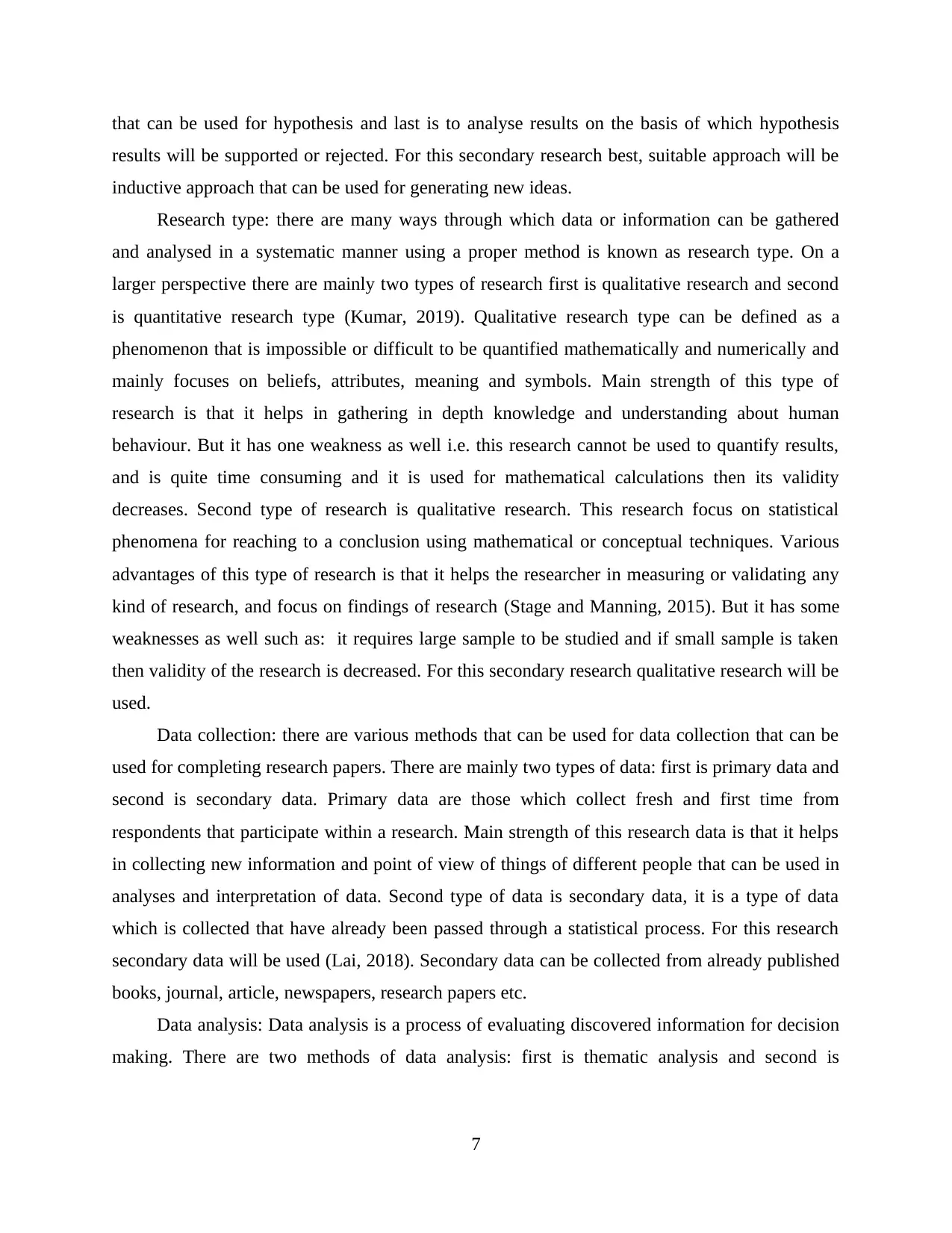
that can be used for hypothesis and last is to analyse results on the basis of which hypothesis
results will be supported or rejected. For this secondary research best, suitable approach will be
inductive approach that can be used for generating new ideas.
Research type: there are many ways through which data or information can be gathered
and analysed in a systematic manner using a proper method is known as research type. On a
larger perspective there are mainly two types of research first is qualitative research and second
is quantitative research type (Kumar, 2019). Qualitative research type can be defined as a
phenomenon that is impossible or difficult to be quantified mathematically and numerically and
mainly focuses on beliefs, attributes, meaning and symbols. Main strength of this type of
research is that it helps in gathering in depth knowledge and understanding about human
behaviour. But it has one weakness as well i.e. this research cannot be used to quantify results,
and is quite time consuming and it is used for mathematical calculations then its validity
decreases. Second type of research is qualitative research. This research focus on statistical
phenomena for reaching to a conclusion using mathematical or conceptual techniques. Various
advantages of this type of research is that it helps the researcher in measuring or validating any
kind of research, and focus on findings of research (Stage and Manning, 2015). But it has some
weaknesses as well such as: it requires large sample to be studied and if small sample is taken
then validity of the research is decreased. For this secondary research qualitative research will be
used.
Data collection: there are various methods that can be used for data collection that can be
used for completing research papers. There are mainly two types of data: first is primary data and
second is secondary data. Primary data are those which collect fresh and first time from
respondents that participate within a research. Main strength of this research data is that it helps
in collecting new information and point of view of things of different people that can be used in
analyses and interpretation of data. Second type of data is secondary data, it is a type of data
which is collected that have already been passed through a statistical process. For this research
secondary data will be used (Lai, 2018). Secondary data can be collected from already published
books, journal, article, newspapers, research papers etc.
Data analysis: Data analysis is a process of evaluating discovered information for decision
making. There are two methods of data analysis: first is thematic analysis and second is
7
results will be supported or rejected. For this secondary research best, suitable approach will be
inductive approach that can be used for generating new ideas.
Research type: there are many ways through which data or information can be gathered
and analysed in a systematic manner using a proper method is known as research type. On a
larger perspective there are mainly two types of research first is qualitative research and second
is quantitative research type (Kumar, 2019). Qualitative research type can be defined as a
phenomenon that is impossible or difficult to be quantified mathematically and numerically and
mainly focuses on beliefs, attributes, meaning and symbols. Main strength of this type of
research is that it helps in gathering in depth knowledge and understanding about human
behaviour. But it has one weakness as well i.e. this research cannot be used to quantify results,
and is quite time consuming and it is used for mathematical calculations then its validity
decreases. Second type of research is qualitative research. This research focus on statistical
phenomena for reaching to a conclusion using mathematical or conceptual techniques. Various
advantages of this type of research is that it helps the researcher in measuring or validating any
kind of research, and focus on findings of research (Stage and Manning, 2015). But it has some
weaknesses as well such as: it requires large sample to be studied and if small sample is taken
then validity of the research is decreased. For this secondary research qualitative research will be
used.
Data collection: there are various methods that can be used for data collection that can be
used for completing research papers. There are mainly two types of data: first is primary data and
second is secondary data. Primary data are those which collect fresh and first time from
respondents that participate within a research. Main strength of this research data is that it helps
in collecting new information and point of view of things of different people that can be used in
analyses and interpretation of data. Second type of data is secondary data, it is a type of data
which is collected that have already been passed through a statistical process. For this research
secondary data will be used (Lai, 2018). Secondary data can be collected from already published
books, journal, article, newspapers, research papers etc.
Data analysis: Data analysis is a process of evaluating discovered information for decision
making. There are two methods of data analysis: first is thematic analysis and second is
7
⊘ This is a preview!⊘
Do you want full access?
Subscribe today to unlock all pages.

Trusted by 1+ million students worldwide
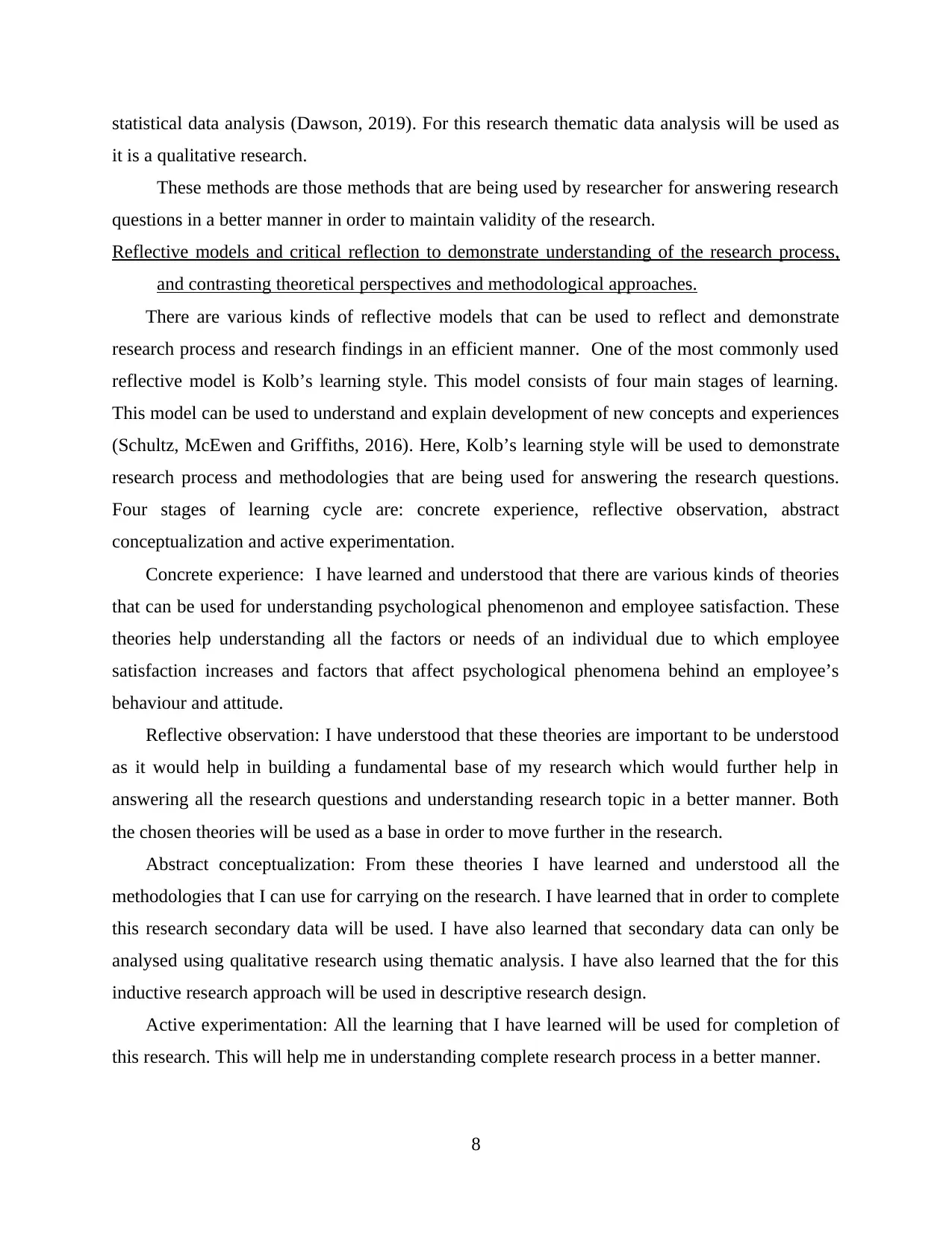
statistical data analysis (Dawson, 2019). For this research thematic data analysis will be used as
it is a qualitative research.
These methods are those methods that are being used by researcher for answering research
questions in a better manner in order to maintain validity of the research.
Reflective models and critical reflection to demonstrate understanding of the research process,
and contrasting theoretical perspectives and methodological approaches.
There are various kinds of reflective models that can be used to reflect and demonstrate
research process and research findings in an efficient manner. One of the most commonly used
reflective model is Kolb’s learning style. This model consists of four main stages of learning.
This model can be used to understand and explain development of new concepts and experiences
(Schultz, McEwen and Griffiths, 2016). Here, Kolb’s learning style will be used to demonstrate
research process and methodologies that are being used for answering the research questions.
Four stages of learning cycle are: concrete experience, reflective observation, abstract
conceptualization and active experimentation.
Concrete experience: I have learned and understood that there are various kinds of theories
that can be used for understanding psychological phenomenon and employee satisfaction. These
theories help understanding all the factors or needs of an individual due to which employee
satisfaction increases and factors that affect psychological phenomena behind an employee’s
behaviour and attitude.
Reflective observation: I have understood that these theories are important to be understood
as it would help in building a fundamental base of my research which would further help in
answering all the research questions and understanding research topic in a better manner. Both
the chosen theories will be used as a base in order to move further in the research.
Abstract conceptualization: From these theories I have learned and understood all the
methodologies that I can use for carrying on the research. I have learned that in order to complete
this research secondary data will be used. I have also learned that secondary data can only be
analysed using qualitative research using thematic analysis. I have also learned that the for this
inductive research approach will be used in descriptive research design.
Active experimentation: All the learning that I have learned will be used for completion of
this research. This will help me in understanding complete research process in a better manner.
8
it is a qualitative research.
These methods are those methods that are being used by researcher for answering research
questions in a better manner in order to maintain validity of the research.
Reflective models and critical reflection to demonstrate understanding of the research process,
and contrasting theoretical perspectives and methodological approaches.
There are various kinds of reflective models that can be used to reflect and demonstrate
research process and research findings in an efficient manner. One of the most commonly used
reflective model is Kolb’s learning style. This model consists of four main stages of learning.
This model can be used to understand and explain development of new concepts and experiences
(Schultz, McEwen and Griffiths, 2016). Here, Kolb’s learning style will be used to demonstrate
research process and methodologies that are being used for answering the research questions.
Four stages of learning cycle are: concrete experience, reflective observation, abstract
conceptualization and active experimentation.
Concrete experience: I have learned and understood that there are various kinds of theories
that can be used for understanding psychological phenomenon and employee satisfaction. These
theories help understanding all the factors or needs of an individual due to which employee
satisfaction increases and factors that affect psychological phenomena behind an employee’s
behaviour and attitude.
Reflective observation: I have understood that these theories are important to be understood
as it would help in building a fundamental base of my research which would further help in
answering all the research questions and understanding research topic in a better manner. Both
the chosen theories will be used as a base in order to move further in the research.
Abstract conceptualization: From these theories I have learned and understood all the
methodologies that I can use for carrying on the research. I have learned that in order to complete
this research secondary data will be used. I have also learned that secondary data can only be
analysed using qualitative research using thematic analysis. I have also learned that the for this
inductive research approach will be used in descriptive research design.
Active experimentation: All the learning that I have learned will be used for completion of
this research. This will help me in understanding complete research process in a better manner.
8
Paraphrase This Document
Need a fresh take? Get an instant paraphrase of this document with our AI Paraphraser
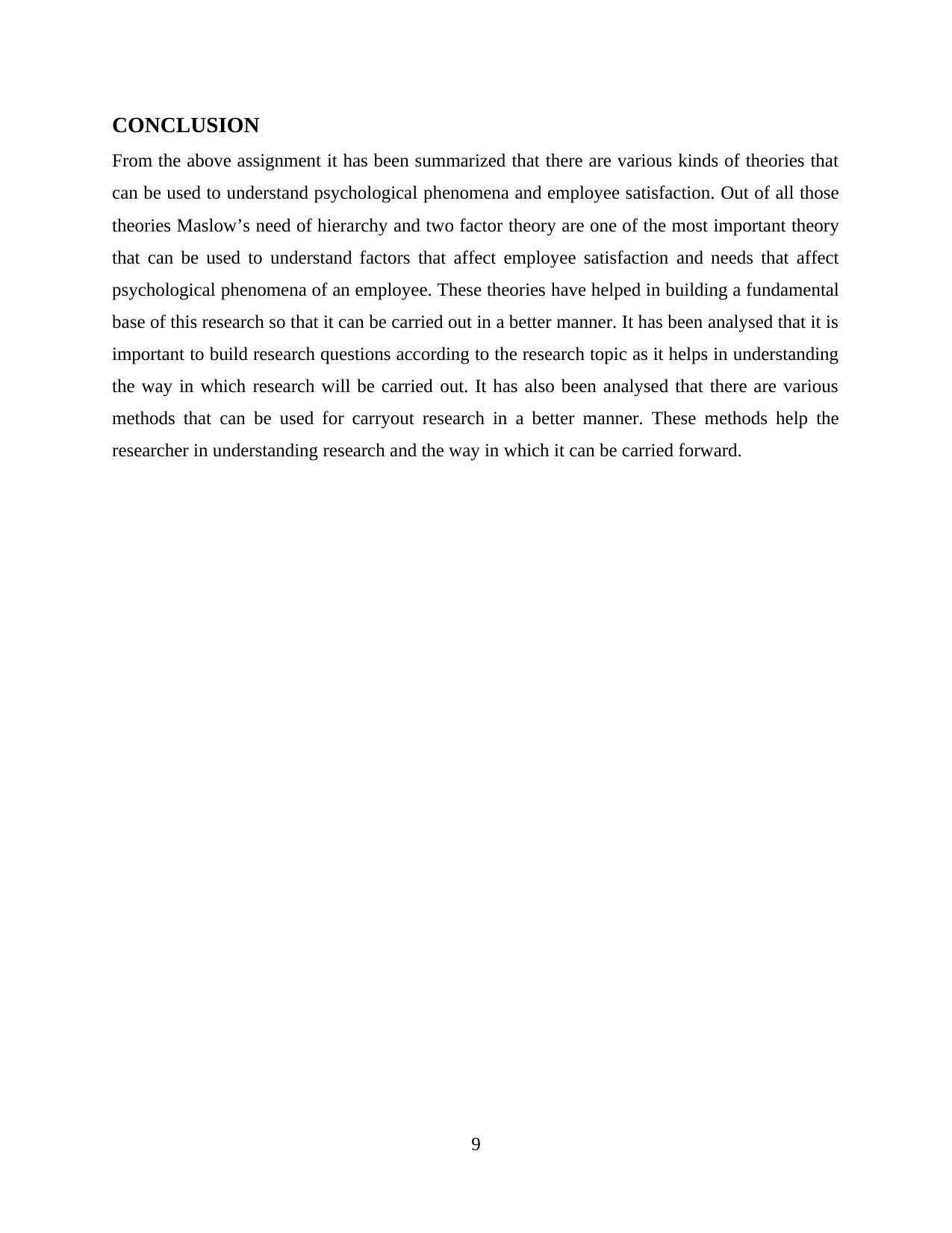
CONCLUSION
From the above assignment it has been summarized that there are various kinds of theories that
can be used to understand psychological phenomena and employee satisfaction. Out of all those
theories Maslow’s need of hierarchy and two factor theory are one of the most important theory
that can be used to understand factors that affect employee satisfaction and needs that affect
psychological phenomena of an employee. These theories have helped in building a fundamental
base of this research so that it can be carried out in a better manner. It has been analysed that it is
important to build research questions according to the research topic as it helps in understanding
the way in which research will be carried out. It has also been analysed that there are various
methods that can be used for carryout research in a better manner. These methods help the
researcher in understanding research and the way in which it can be carried forward.
9
From the above assignment it has been summarized that there are various kinds of theories that
can be used to understand psychological phenomena and employee satisfaction. Out of all those
theories Maslow’s need of hierarchy and two factor theory are one of the most important theory
that can be used to understand factors that affect employee satisfaction and needs that affect
psychological phenomena of an employee. These theories have helped in building a fundamental
base of this research so that it can be carried out in a better manner. It has been analysed that it is
important to build research questions according to the research topic as it helps in understanding
the way in which research will be carried out. It has also been analysed that there are various
methods that can be used for carryout research in a better manner. These methods help the
researcher in understanding research and the way in which it can be carried forward.
9
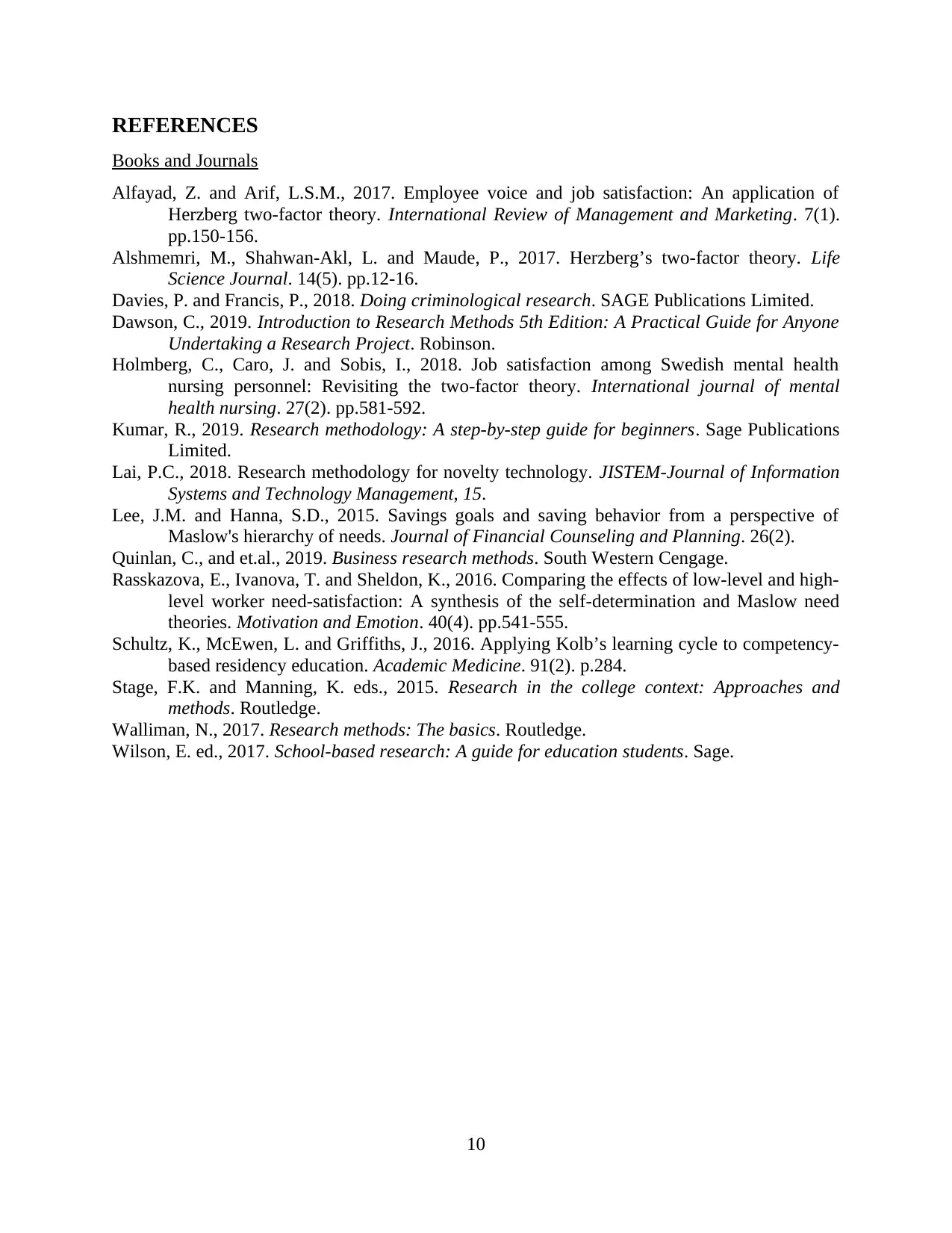
REFERENCES
Books and Journals
Alfayad, Z. and Arif, L.S.M., 2017. Employee voice and job satisfaction: An application of
Herzberg two-factor theory. International Review of Management and Marketing. 7(1).
pp.150-156.
Alshmemri, M., Shahwan-Akl, L. and Maude, P., 2017. Herzberg’s two-factor theory. Life
Science Journal. 14(5). pp.12-16.
Davies, P. and Francis, P., 2018. Doing criminological research. SAGE Publications Limited.
Dawson, C., 2019. Introduction to Research Methods 5th Edition: A Practical Guide for Anyone
Undertaking a Research Project. Robinson.
Holmberg, C., Caro, J. and Sobis, I., 2018. Job satisfaction among Swedish mental health
nursing personnel: Revisiting the two‐factor theory. International journal of mental
health nursing. 27(2). pp.581-592.
Kumar, R., 2019. Research methodology: A step-by-step guide for beginners. Sage Publications
Limited.
Lai, P.C., 2018. Research methodology for novelty technology. JISTEM-Journal of Information
Systems and Technology Management, 15.
Lee, J.M. and Hanna, S.D., 2015. Savings goals and saving behavior from a perspective of
Maslow's hierarchy of needs. Journal of Financial Counseling and Planning. 26(2).
Quinlan, C., and et.al., 2019. Business research methods. South Western Cengage.
Rasskazova, E., Ivanova, T. and Sheldon, K., 2016. Comparing the effects of low-level and high-
level worker need-satisfaction: A synthesis of the self-determination and Maslow need
theories. Motivation and Emotion. 40(4). pp.541-555.
Schultz, K., McEwen, L. and Griffiths, J., 2016. Applying Kolb’s learning cycle to competency-
based residency education. Academic Medicine. 91(2). p.284.
Stage, F.K. and Manning, K. eds., 2015. Research in the college context: Approaches and
methods. Routledge.
Walliman, N., 2017. Research methods: The basics. Routledge.
Wilson, E. ed., 2017. School-based research: A guide for education students. Sage.
10
Books and Journals
Alfayad, Z. and Arif, L.S.M., 2017. Employee voice and job satisfaction: An application of
Herzberg two-factor theory. International Review of Management and Marketing. 7(1).
pp.150-156.
Alshmemri, M., Shahwan-Akl, L. and Maude, P., 2017. Herzberg’s two-factor theory. Life
Science Journal. 14(5). pp.12-16.
Davies, P. and Francis, P., 2018. Doing criminological research. SAGE Publications Limited.
Dawson, C., 2019. Introduction to Research Methods 5th Edition: A Practical Guide for Anyone
Undertaking a Research Project. Robinson.
Holmberg, C., Caro, J. and Sobis, I., 2018. Job satisfaction among Swedish mental health
nursing personnel: Revisiting the two‐factor theory. International journal of mental
health nursing. 27(2). pp.581-592.
Kumar, R., 2019. Research methodology: A step-by-step guide for beginners. Sage Publications
Limited.
Lai, P.C., 2018. Research methodology for novelty technology. JISTEM-Journal of Information
Systems and Technology Management, 15.
Lee, J.M. and Hanna, S.D., 2015. Savings goals and saving behavior from a perspective of
Maslow's hierarchy of needs. Journal of Financial Counseling and Planning. 26(2).
Quinlan, C., and et.al., 2019. Business research methods. South Western Cengage.
Rasskazova, E., Ivanova, T. and Sheldon, K., 2016. Comparing the effects of low-level and high-
level worker need-satisfaction: A synthesis of the self-determination and Maslow need
theories. Motivation and Emotion. 40(4). pp.541-555.
Schultz, K., McEwen, L. and Griffiths, J., 2016. Applying Kolb’s learning cycle to competency-
based residency education. Academic Medicine. 91(2). p.284.
Stage, F.K. and Manning, K. eds., 2015. Research in the college context: Approaches and
methods. Routledge.
Walliman, N., 2017. Research methods: The basics. Routledge.
Wilson, E. ed., 2017. School-based research: A guide for education students. Sage.
10
⊘ This is a preview!⊘
Do you want full access?
Subscribe today to unlock all pages.

Trusted by 1+ million students worldwide
1 out of 12
Related Documents
Your All-in-One AI-Powered Toolkit for Academic Success.
+13062052269
info@desklib.com
Available 24*7 on WhatsApp / Email
![[object Object]](/_next/static/media/star-bottom.7253800d.svg)
Unlock your academic potential
Copyright © 2020–2025 A2Z Services. All Rights Reserved. Developed and managed by ZUCOL.




